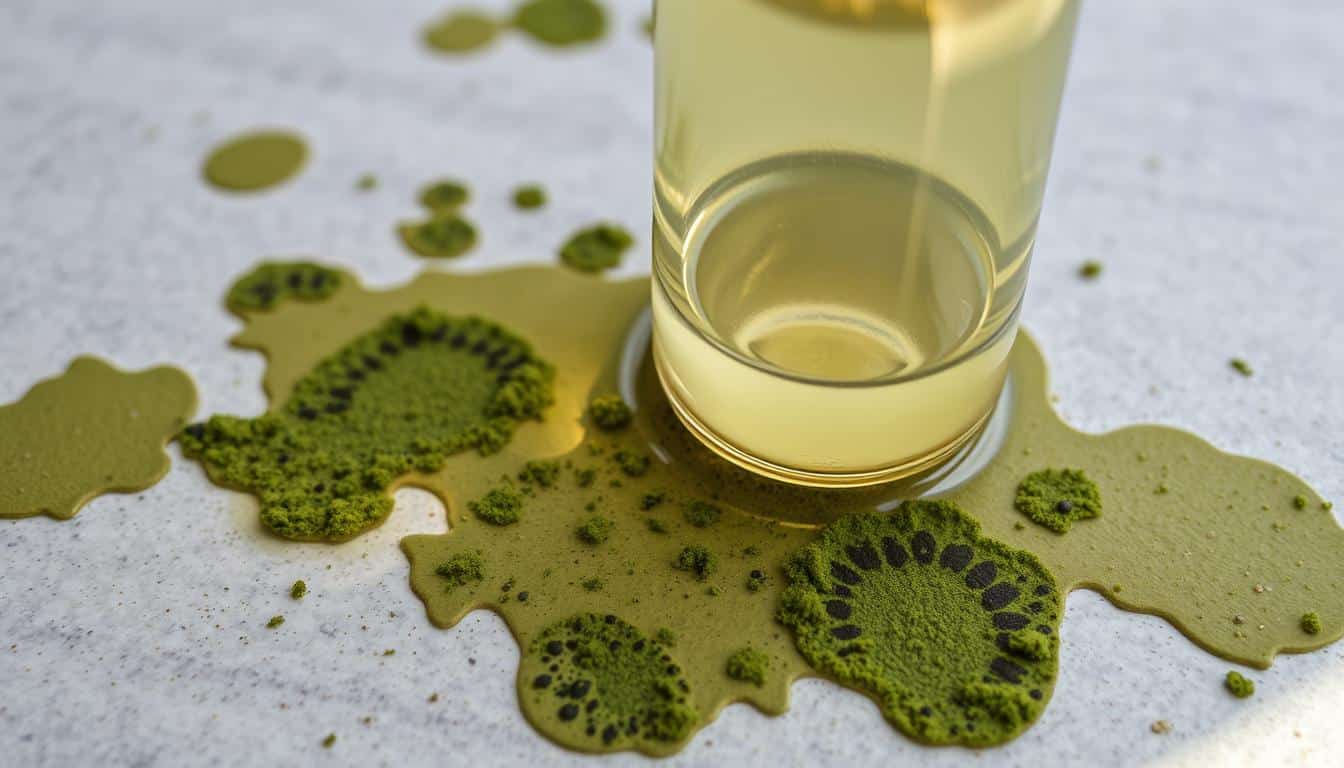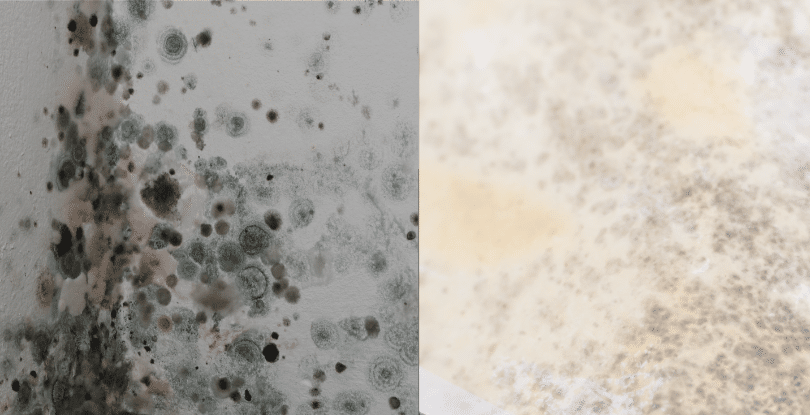Mold is a common problem in damp areas of the home. It can cause health issues like allergic reactions and breathing problems. Many people use vinegar as a natural and affordable way to remove mold. But, does vinegar really kill mold for good? This article will look into vinegar’s impact on mold and when to call in the experts.
Key Takeaways
- Vinegar is a mild acid that kills 82% of mold species, but its effectiveness can vary based on the acidity level.
- Vinegar may not be effective against certain types of mold, such as Aspergillus fumigatus, a common household mold.
- Vinegar is not recommended for cleaning mold on porous surfaces like concrete, wood, or carpet, as it can potentially damage the material.
- Larger mold infestations covering more than 10 square feet should be handled by professional mold remediation experts.
- Proper personal protective equipment, such as gloves, masks, and eye protection, is crucial when cleaning mold to avoid health risks.
The Short Answer
Yes, vinegar can kill mold in many cases. Household white vinegar has 5-8% acetic acid. This acid disrupts the growth of fungi and microorganisms, including common household molds.
Does Vinegar Kill Mold?
Studies show vinegar can stop mold growth on fruits and remove some mold types, like Penicillium chrysogenum. But, it might not work against all mold, like Aspergillus fumigatus. The Environmental Protection Agency suggests getting professionals for mold over 10 square feet.
A 2015 study found vinegar with 4% acetic acid can kill Penicillium chrysogenum mold. Vinegar is better than bleach for cleaning drywall because it kills mold deeper than bleach does.
| Mold Type | Vinegar Effectiveness |
|---|---|
| Penicillium chrysogenum | Effective |
| Aspergillus fumigatus | Not Effective |
Vinegar can kill over 80% of mold species, making it a safe choice. But, don’t use it on concrete as it can harm the cement.
Vinegar can be a preventive measure in areas prone to mold growth, such as basements, and can improve indoor air quality by reducing mold spores, particularly beneficial for individuals with allergies or respiratory issues.
Why Vinegar Isn’t Effective on Mold
Vinegar can help with surface mold, but it’s not enough for deep mold problems. Mold like Stachybotrys chartarum goes deep into materials like drywall and wood. Vinegar’s acid can’t always get to and kill all the mold.
Vinegar can’t get deep into porous surfaces. So, mold can still grow under the surface after treatment. Experts say it’s better to replace moldy materials than try to clean them with vinegar.
The success of vinegar on mold also depends on the mold type, how bad it is, and the area’s moisture. Vinegar works well for small surface mold but not for big or deep mold problems.
In short, vinegar is good for some mold issues but not all. For serious mold, it’s best to get help from mold removal experts. They can solve the problem fully.
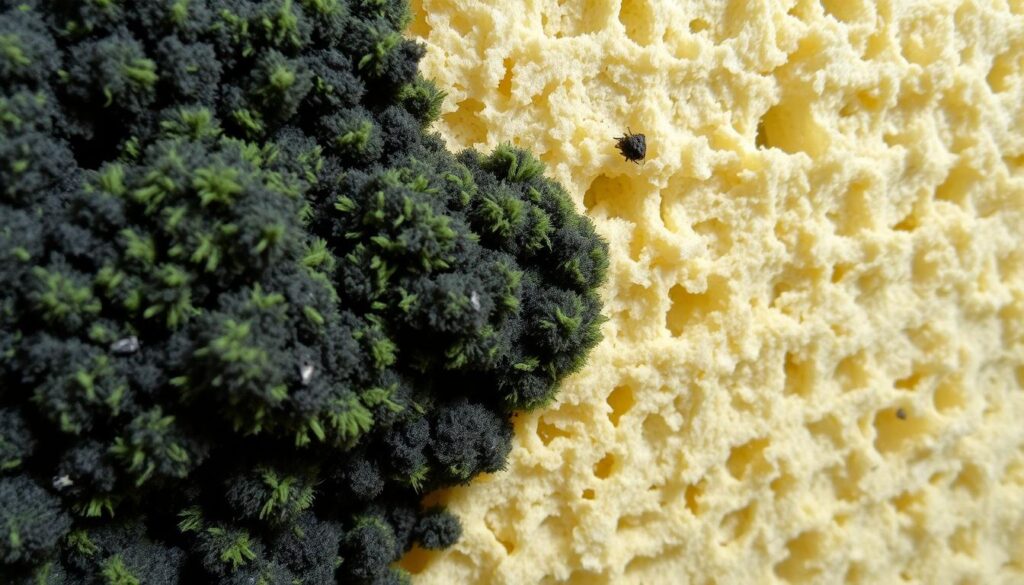
| Mold Type | Vinegar Effectiveness | Recommended Solution |
|---|---|---|
| Surface-level Mold | Effective | Vinegar treatment |
| Deeply Rooted Mold | Limited | Professional mold removal |
| Mold on Porous Surfaces | Ineffective | Replace affected materials |
Will Vinegar Kill Mold Permanently
Vinegar can remove surface mold but might not stop it from coming back. It has 5-20% acetic acid, which kills about 82% of mold on surfaces. But, the mold’s roots can still grow back if moisture issues aren’t fixed.
Vinegar is a safe, natural way to kill mold, approved by the US EPA. It works well on pink, white, and green mold on surfaces like glass and metal. But, for black mold or mold on wood and drywall, vinegar might not work, and you might need a pro.
To keep mold away for good, fix any moisture problems. Regular cleaning with vinegar can also help, especially in humid places like bathrooms and kitchens.
Before using vinegar, test it on a small area first. Wear protective gear and consider getting help for big mold problems. Vinegar is a good tool against mold, but it’s not always enough on its own.
| Mold Removal Method | Effectiveness | Safety Considerations |
|---|---|---|
| Vinegar | – Effective for up to 82% of mold species on porous surfaces – May not be as effective on severe black mold or porous materials | – Non-toxic and eco-friendly – Wear protective gear (gloves, goggles, mask) |
| Bleach | – Effective on non-porous surfaces – Diluted 1:10 ratio (1 cup bleach to 1 gallon water) | – Toxic and can release harmful fumes – Wear protective gear (gloves, goggles, mask) |
The lasting effect of vinegar on mold depends on fixing moisture problems and keeping things clean and dry. Vinegar is useful, but it’s not always enough to get rid of mold for good.
Can Vinegar Kill Mildew?
Mildew is a common problem that grows on hard surfaces like tile and plastic. It’s different from deeper mold and can be treated with vinegar. Vinegar is a natural and eco-friendly cleaner.
How to Use Vinegar on Mildew
Here’s how to use vinegar to tackle mildew in your home:
- Start by ventilating the area by opening doors and windows to allow for proper air circulation.
- Spray undiluted white vinegar directly onto the affected mildew-covered surfaces.
- Let the vinegar soak in for about an hour, giving it time to work its magic.
- After the waiting period, wipe or scrub the mildew until it is completely removed.
Vinegar is great for mildew because it doesn’t go deep into surfaces. This makes it perfect for surface-level mildew issues.
| Mold vs Mildew | Mold | Mildew |
|---|---|---|
| Growth Pattern | Grows in depth, penetrating surfaces | Grows on the surface, not as deeply rooted |
| Appearance | Fuzzy or slimy, can be various colors | Powdery or flat, typically white or gray |
| Difficulty to Remove | More difficult to remove, often requires professional assistance | Easier to remove with household cleaners like vinegar |
Knowing the difference between mold and mildew helps you use vinegar better. Vinegar is safer and more eco-friendly than harsh chemicals.
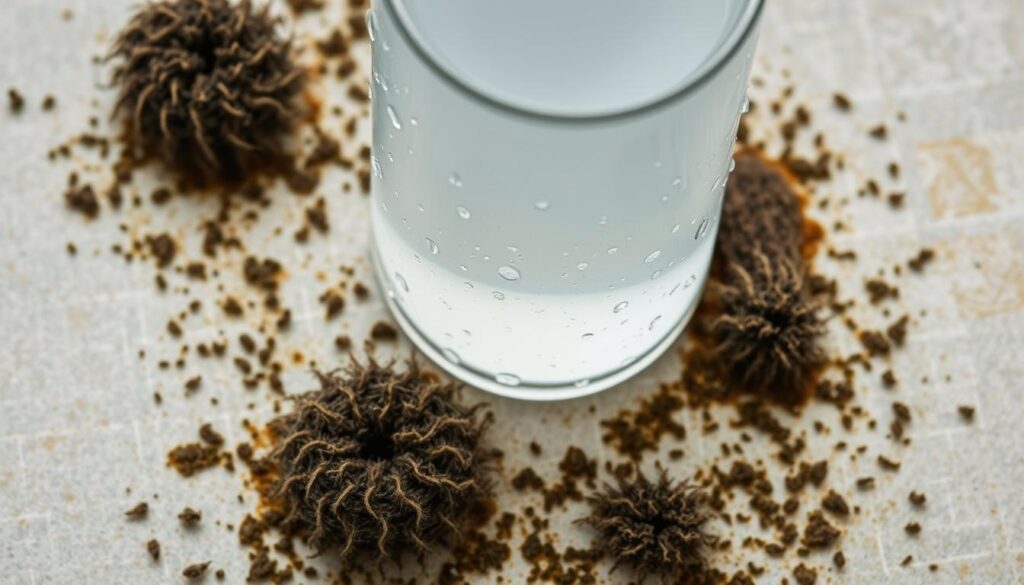
What Surfaces Can You Use Vinegar on?
Vinegar is a natural and effective way to kill mold on many surfaces. But, not all surfaces can handle vinegar. We’ll look at where vinegar works best and where it’s best to avoid it.
Surfaces to Use Vinegar on for Mold
- Drywall: Vinegar is great for cleaning mold off drywall. It can get deep into the surface to kill the mold.
- Leather: Vinegar is safe to use on leather. It can remove mold without harming the leather.
Surfaces to Avoid Using Vinegar
Vinegar is a strong cleaner, but it’s not for every surface:
- Concrete: Vinegar’s acidity can damage and etch concrete. It’s best to avoid using it on concrete.
- Finished Wood Floors: Vinegar can harm the protective finish on wood floors. It can cause damage over time.
- Stone Surfaces: The acidity in vinegar can dull and etch marble, limestone, and granite. It’s not good for these materials.
- Porous Surfaces: Vinegar may not work well on very porous surfaces like ceiling tiles or carpeting. It can’t get deep enough to kill the mold.
| Surface | Vinegar Effectiveness |
|---|---|
| Drywall | Highly effective |
| Leather | Effective |
| Concrete | Not recommended |
| Finished Wood Floors | Not recommended |
| Stone Surfaces | Not recommended |
| Porous Surfaces | Not effective |
“Vinegar is a powerful natural cleaning agent, but it’s important to use it wisely and avoid damaging your surfaces.”
Does Vinegar Kill Mold Better than Bleach?
Many homeowners wonder if vinegar or bleach is better for mold removal. Bleach can kill surface mold but is not safe for DIY cleaning. It’s much more toxic than vinegar and can harm you if not used carefully.
Bleach only kills the mold you see, not the roots. This means mold can come back. Professional cleaners might use bleach, but they know how to handle it safely.
Vinegar is safer and often works better than bleach for homeowners. It can kill up to 80% of common home mold species. Vinegar is also good for removing mold from materials like wood and drywall, where bleach fails.
The EPA warns against using bleach for mold removal. It can make mold grow worse if it touches the mold colonies. Bleach works only on non-porous surfaces. Vinegar can get into porous materials to kill mold at its roots.
| Mold Removal Method | Effectiveness | Safety Concerns |
|---|---|---|
| Vinegar | Highly effective, can kill up to 80% of mold species | Safer for homeowners, low toxicity |
| Bleach | Effective on surface-level mold, but cannot reach the roots | Toxic fumes, can cause aggressive mold growth |
In summary, vinegar is a better choice than bleach for DIY mold cleaning. It’s safer, more effective, and recommended by the EPA for home mold removal.
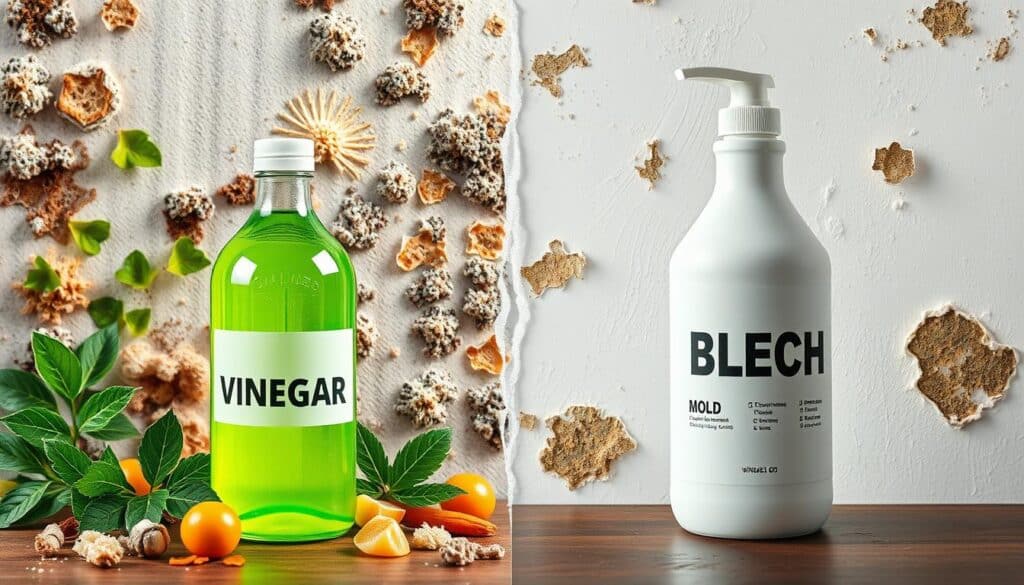
What Should You Do When You Find Mold?
Finding mold in your home can be scary and overwhelming. It’s key to act fast but safely. The Environmental Protection Agency (EPA) suggests getting a pro for mold removal if it’s over 10 square feet.
Signs You Need Professional Mold Removal
Other signs you might need a mold expert include:
- Musty smells that won’t go away
- Mold spreading on many surfaces
- Health issues like constant breathing problems
- Mold in the HVAC system or hard-to-reach spots
Trying to clean up big mold problems without the right tools can fail and be risky. It’s safer to get a pro if you’re not sure about the mold size.
The EPA recommends professional mold removal if the mold area is over 10 square feet in size.
Following EPA guidelines for mold removal is key to fix the mold right and safely. This stops it from getting worse or harming your home. Don’t wait to call the experts when what to do when find mold in your home.
How to Prevent Mold in the Future
To stop mold problems, prevent it from growing. Keep your home dry and clean. This way, you won’t need to deal with big mold issues later.
Tips for Mold Prevention
To prevent mold growth, keep indoor humidity levels below 50%. Mold loves damp places. So, controlling moisture inside is crucial. Also, fix leaks right away and improve home ventilation to stop mold from growing.
- Reduce indoor humidity with dehumidifiers, exhaust fans, and good ventilation in kitchens and bathrooms.
- Address water leaks quickly, as small leaks can cause mold over time.
- Improve airflow by making sure all rooms have enough ventilation to prevent moisture buildup.
- Practice regular cleaning to get rid of dust, crumbs, and other things mold eats.
- Think about adding mold-inhibiting additives to paint when you redecorate.
By following these steps to prevent mold growth, you can avoid expensive and time-consuming mold removal in the future.
Alternative Mold Removal Solutions
Vinegar is a common home remedy, but it’s not the only choice for mold removal. Natural solutions like tea tree oil, hydrogen peroxide, and baking soda work well. These options are better for the environment and can save money.
Tea Tree Oil for Mold
Tea tree oil has been used for centuries to fight mold. It’s more effective than vinegar and other cleaners. Its strong antimicrobial properties make it a great tool against mold.
Hydrogen Peroxide for Mold
Hydrogen peroxide can kill fungi on hard surfaces. It’s not as good on soft materials, but it’s still useful. Be careful with it because it can irritate skin and eyes.
Baking Soda for Mold
Baking soda is good at fighting mold because of its antimicrobial properties. Mix it with water to make a paste for cleaning. It’s cheap, easy to find, and safe for people and pets.
Before trying these methods, do your homework. Wear protective gear and make sure the area is well-ventilated. This will help you remove mold safely and effectively.
| Mold Removal Method | Effectiveness | Safety | Cost |
|---|---|---|---|
| Tea Tree Oil | High | Low Toxicity | Moderate |
| Hydrogen Peroxide | Moderate | Moderate Toxicity | Low |
| Baking Soda | High | Very Low Toxicity | Low |
“Mold primarily exists in predictable locations in homes like damp and cold basements, cellars, bathrooms, and garages.”
Conclusion
Vinegar can help with surface mold and mildew, but it’s not enough for deep fungal growth. As a homeowner, I’ve found that vinegar alone isn’t enough. Mold can come back if moisture issues aren’t fixed.
For bigger mold problems, getting help from professional mold remediation services is best. These experts have the right tools and knowledge to get rid of mold for good. Keeping humidity low, fixing leaks fast, and staying clean also helps prevent mold.
Vinegar is useful, but it’s not a complete solution. Knowing its limits and when to call professionals helps keep my home mold-free. This way, my family and I can enjoy a healthy, safe home.
FAQ
Does Vinegar Kill Mold?
Yes, vinegar can kill mold in many cases. The acetic acid in household white vinegar has antifungal properties. It disrupts the growth of a wide range of fungi and microorganisms, including common household molds.
Why Isn’t Vinegar Effective on All Types of Mold?
Vinegar can kill surface-level mold but struggles to penetrate deep. Mold roots itself deeply into materials like drywall and wood. This makes it hard for vinegar to destroy the mold fully.
Will Vinegar Kill Mold Permanently?
No, vinegar won’t kill mold permanently. It can remove visible mold but the mold’s roots often remain. Unless moisture issues are fixed, mold will likely return after vinegar treatment.
Can Vinegar Kill Mildew?
Yes, vinegar can kill mildew, a type of surface mold. It works well on mildew because it doesn’t penetrate deeply. This makes it less effective on more entrenched mold growth.
What Surfaces Can You Use Vinegar On?
Vinegar works well on drywall and leather. But it should be avoided on concrete, finished wood floors, and stone surfaces like marble and limestone. It can damage these materials. Vinegar is also not suitable for cleaning mold off porous surfaces like ceiling tiles or carpeting.
Is Vinegar Better than Bleach for Killing Mold?
Yes, vinegar is safer and more effective than bleach for mold cleanup. Bleach is toxic and only kills surface-level mold without penetrating to eliminate the roots.
When Should I Call a Professional Mold Removal Company?
Call a professional if the mold covers more than 10 square feet or has penetrated the HVAC system or other hard-to-access areas. Signs that professional help is needed include musty odors, widespread mold growth, and persistent health issues that may be linked to mold exposure.
How Can I Prevent Mold From Growing in My Home?
To prevent mold, maintain indoor humidity below 50%. Address water leaks or damage immediately. Ensure proper home ventilation. Regularly clean to remove organic materials that mold feeds on.
What Other Natural Solutions Can I Use for Mold Removal?
Besides vinegar, natural alternatives for mold removal include tea tree oil, hydrogen peroxide, and baking soda. These solutions have antimicrobial properties that can help inhibit and control mold growth.


